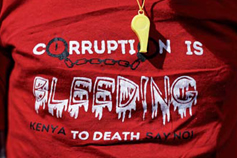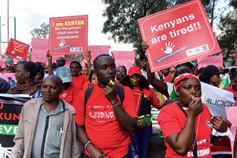When Corruption Violates Human Rights: The Right to Food in Kenya
 Hunger is a violation of human dignity and an obstacle to social, political and economic progress. Yet millions of people in Kenya are prevented from realising the fundamental human right to be free from hunger because of government corruption and abuse of power.
Hunger is a violation of human dignity and an obstacle to social, political and economic progress. Yet millions of people in Kenya are prevented from realising the fundamental human right to be free from hunger because of government corruption and abuse of power.
In 2012, officials of the Kenya National Federation of Agricultural Producers (KENFAP) accused the government of economic sabotage. According to KENFAP, government corruption led to artificial food shortages in the North Rift. Specifically, the government is accused of deliberately and consistently delaying the disbursement of funds to the National Cereals and Produce Board (NCPB) for the buying of maize. KENFAP alleges that such delays force farmers to sell their produce at throwaway prices to agents working with high powered syndicates connected to government operatives. The maize is then sold by the syndicates at inflated prices in times of scarcity or exported at high prices.
This is one of many examples of alleged abuse of power for private gain by Kenyan government officials leading to a reduced ability by Kenyan people to feed themselves. Other examples include the land grabs. According to FIAN, an international human rights organisation with consultative status to the United Nations, in both of these cases state authorities breach their human rights obligations towards the local population.
The right of everyone to be free from hunger is related to the more general right to an adequate standard of living recognised in article 11 of the International Covenant on Economic, Social and Cultural Rights, which Kenya ratified in 1972. The Covenant imposes a wide range of duties on states parties to ensure that all people are in a position to feed themselves. Duties include improving methods of production, conservation and distribution of food, and developing or reforming agrarian systems to improve the utilisation of natural resources (art.11(2)(a)). Yet programs ostensibly designed to implement these duties and to regulate public and private services in order to achieve food security have provided opportunities for corruption in Kenya including diverting essential resources from social spending.
 These corrupt practices have a disproportionate impact on vulnerable and disadvantaged groups, such as women and children, by undermining the realisation of their right to freedom from hunger. The 1996 Declaration of the World Food Summit expressly identified corruption as one of the causes of food insecurity, while the UN Special Rapporteur on the right to food cites corruption as one of the seven major economic obstacles that hinder or prevent the realisation of the right (see para.69). An important structural connection between corruption and human rights is the role of governments. Governments have the obligation to prevent corruption and to respect, protect and fulfil human rights. Governments also have an important role in creating a space where citizens can safely engage in challenging corruption and advocating for human rights.
These corrupt practices have a disproportionate impact on vulnerable and disadvantaged groups, such as women and children, by undermining the realisation of their right to freedom from hunger. The 1996 Declaration of the World Food Summit expressly identified corruption as one of the causes of food insecurity, while the UN Special Rapporteur on the right to food cites corruption as one of the seven major economic obstacles that hinder or prevent the realisation of the right (see para.69). An important structural connection between corruption and human rights is the role of governments. Governments have the obligation to prevent corruption and to respect, protect and fulfil human rights. Governments also have an important role in creating a space where citizens can safely engage in challenging corruption and advocating for human rights.
So what steps has the Kenyan Government taken to curb corruption and to promote human rights? Different sources of information paint an inconsistent picture. For example, Kenya was the first country in the world to sign and simultaneously ratify the United Nations Convention against Corruption (UNCAC) when it was opened for signature in December 2003. But while the Government has taken a number of initiatives to eliminate corruption, opinion polls suggest the public remains pessimistic about the likelihood of reducing or eliminating it. The Corruption Perception Index (CPI), an instrument ranking countries according to perceptions of corruption in the public sector, found Kenya to be in the top 30 of most corrupt countries. It ranked 145 of the 175 countries included in the 2014 Index. A similar contradiction is apparent in the human rights field. Despite the Kenyan Government claiming at its Universal Periodic Review that it is committed to protecting, and despite the fact it is party to 8 major Human Rights Treaties, human rights defenders in Kenya face increasing levels of danger and risk to their lives. For the last five years, the Human Rights Risk Index, a global assessment tool of human rights violations on the ground, has rated Kenya as ‘high risk’.
These inconsistencies suggest that combating corruption and human rights violations, and forcing governments to take effective action in pursuit of these ends, requires strong collective efforts from different sectors in society acting in co-coordinated ways (Transparency International, 2009). Although NGOs, business associations, scholars, media, and other civil society organisations play a crucial role in efforts to combat corruption and human rights violations, most of their work currently takes place in parallel rather than in collaboration. Likewise, international anticorruption conventions rarely refer to human rights, and major human rights instruments rarely mention corruption.
One of the obstacles to greater collaboration is the perception that anti-corruption organisations are capable of working with governments, while human rights organisations are more adversarial. Another obstacle is the language and approach used by the two movements. Anti-corruption specialists often find the language and concepts of human rights alien and abstract and the approach of human rights defenders inadequate because of their failure to focus on practical solutions. Human rights workers, on the other hand, often ignore opportunities to use specific legal instruments to combat acts of corruption as a means of fighting human rights violations (Transparency International, 2009).
No doubt, useful collaboration between the fields will require efforts on both sides to overcome differences of language and practice. To assist such collaboration, the International Council on Human Rights Policy and Transparency International have identified some strategies and opportunities to foster links between human rights and anticorruption organisations in order to combat corruption and human rights violations.
One strategy is awareness raising and empowerment of people. Demand and support from the public and from human rights organisations for anti-corruption reforms will strengthen the impact of anti-corruption organisations. One noteworthy example of this strategy is the first issue of Living Large – Counting the Cost of Official Extravagance in Kenya. The document explains how instances of corruption, such as the purchase of luxury official cars, affects the lives of ordinary citizens.
Another strategy is strengthening new alliances and engaging the media. Successful anti-corruption strategies require the creation of national and international alliances involving actors from across civil society, government, and the private sector. Therefore, anticorruption and human rights organisations need to strengthen their relationships with politicians and journalists, development and business associations, grassroots and popular movements, and youth. This may involve some work to make human rights language and concepts more accessible and less abstract. Meanwhile, the effective use of a broad range of media has a great capacity to influence the development of anti-corruption awareness among young people.
The growing availability of data and the application of new analytical techniques, such as budget monitoring, is another potentially effective strategy. Embezzlement of public funds is frequent in both national and local government, especially from social budgets. Analysis and scrutiny of public resources and spending at many levels, reported against a sector (such as education or health), or a specific group (such as women or minorities), is a useful tool to assess how public resources are spent.
Under Kenya’s new devolved system of government, many public services which are crucial to disadvantaged groups and which are often vulnerable to corruption are delivered by county governments. Thus, impelling county governments to be publicly accountable is another potential strategy. While litigation has its value, it also has its difficulties, such as securing victims’ consent to a prosecution or recruiting them as witnesses. In addition, lawsuits may bring serious risks of harm for those involved. Thus, litigation should only be used after careful consideration and preferably as part of a broader strategy.
The multi-layered mechanics of corruption in Kenya are complex and its impact on vulnerable and disadvantaged groups is pressing. But integrated, collaborative efforts between human rights and anti-corruption organisations have the potential to curb corruption and promote human rights, including the right to be free from hunger, for all Kenyans.